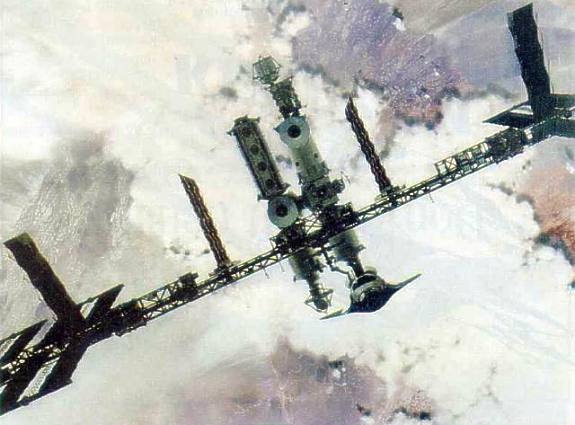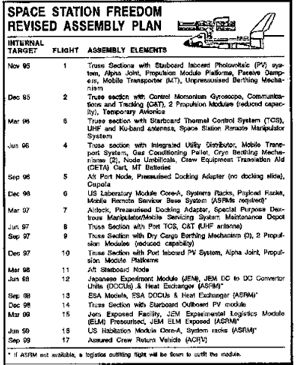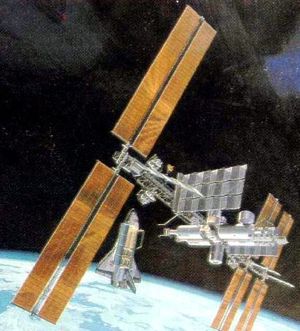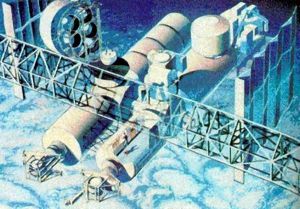
Home - Search - Browse - Alphabetic Index: 0- 1- 2- 3- 4- 5- 6- 7- 8- 9
A- B- C- D- E- F- G- H- I- J- K- L- M- N- O- P- Q- R- S- T- U- V- W- X- Y- Z
Space Station Fred

Fred Station 1991
1991 Fred Space Station Redesign.
Credit: NASA via Marcus Lindroos
Status: Design 1991.
The resulting configuration was mockingly referred to as 'Fred' by the programs critics, underscoring the truncated nature of the design. The Space Station assembly sequence was greatly simplified by switching to shorter, prefabricated truss segments that required no assembly in space. Only 250-300 hours of annual EVA 'spacewalks' were now required for maintaining the Station's external areas. One set of solar arrays were deleted, reducing the power from 75 kW to 56 kW although 30 kW still would be available for users.
The total cost was reduced by $1.6 billion, to $16.9 billion (=$11.2 billion in 1984 dollars) as the maximum annual budget was reduced from $3 billion to $2.5 billion. NASA intended to spend $2.02 billion on the project in Fiscal Year 1992, followed by $2.3 billion in FY 1993, $2.5-2.6 billion/year in 1994-96. The redesigned Space Station would have required a total of 23 Shuttle launches vs. about 29 for the previous configuration. The first launch was now scheduled for November 1995 and the Station would be permanently manned in September 1999 after 17 Shuttle flights.
'Fred' was considerably smaller than its predecessor, spanning only 108 meters across as the 'Dual Keel' adapter segments finally were deleted for good. General Electric's Work Package 3 contract with NASA/Goddard was terminated along with the Station's remaining external payloads and polar platform. The only remaining mission was now life sciences and microgravity research.
The length of the crew modules was reduced to 8.2 meters to reduce the weight while allowing them to be tested, integrated and outfitted on the ground rather than in space. The US laboratory and habitation modules were retained but the two node modules were deleted. The total pressurized volume was now 878 cubic meters. The crew was reduced from eight astronauts to four. Space Station Freedom's advanced life support system was replaced with a cheaper and simpler design which did not recycle all water and oxygen, at the cost of greatly increasing the mass of the supplies that had to be launched from Earth. The redesigned US laboratory module now contained 15 experiment racks. Scientists complained about the lack of power and reduced 50mbits/s data transmission rate, down from the 1987 design's 300mbits/s. There would also be no centrifuge module for life science research, and the crew of four was regarded as too small for serious scientific work by many scientists.
Although the 1991 redesign greatly enhanced NASA's capability to actually build and launch the Space Station, the project continued to be unpopular with politicians and scientists. In May 1991, a House Appropriations subcommittee voted to terminate the project although the full House of Representatives reversed the decision a month later. The project received its full $2.03-billion Fiscal 1992 budget, but only after some other NASA projects were cancelled.
The Station dodged another bullet in August 1992 when an amendment to cancel the project failed, 181-237. NASA then had to absorb a $150-million Space Station budget reduction in Fiscal 1993 as the project entered its early flight hardware production phase. NASA was now forced to slip the first launch by four months into 1996 while the man-tended Space Station operations phase would be delayed by six months. The capability to support a permanent crew was delayed by nine months. The end of the Cold War lead to calls for reduced spending on defense and space programs. Following reports of new cost overruns of $1 billion in Fiscal 1993-95, the new Clinton Administration finally ordered a new redesign in March 1993. NASA was to provide three alternatives costing $5, $7 and $9 billion (Fiscal 1994-98) by June 1993. The important objectives were: maintain international commitments, advance the date for Permanent Manned Capability to 1998, preserve as much previously designed hardware and growth potential as possible while meeting minimum life science and microgravity objectives, cut astronaut EVA requirements, flight, mission operations and logistics by 50%, and streamline technical and program management. This redesign marked the end of Space Station Fred and the transition to the International Space Station.
Article by Marcus Lindroos
Family: Space station, USA - Space Stations. Country: USA. Launch Vehicles: Space Shuttle. Agency: NASA.
 | 1991 Fred Assembly 1991 Fred Space Station Redesign. Credit: NASA via Marcus Lindroos |
 | Space Station Fred Fred Space Station Crew Modules. Inside the redesigned Fred habitation module. The crew was reduced from eight astronauts to four. Credit: NASA via Marcus Lindroos |
 | Space Station Fred Fred Space Station Crew Modules. Cutaway drawing of the new 8.2-meter Fred habitation module. The galley and gymnasium are visible at left. Credit: NASA via Marcus Lindroos |
 | Space Station Fred Fred Space Station Crew Modules. The redesigned US laboratory module now contained 15 experiment racks. Credit: NASA via Marcus Lindroos |
 | Space Station Fred Credit: NASA via Marcus Lindroos |
Back to top of page
Home - Search - Browse - Alphabetic Index: 0- 1- 2- 3- 4- 5- 6- 7- 8- 9
A- B- C- D- E- F- G- H- I- J- K- L- M- N- O- P- Q- R- S- T- U- V- W- X- Y- Z
© 1997-2019 Mark Wade - Contact
© / Conditions for Use



